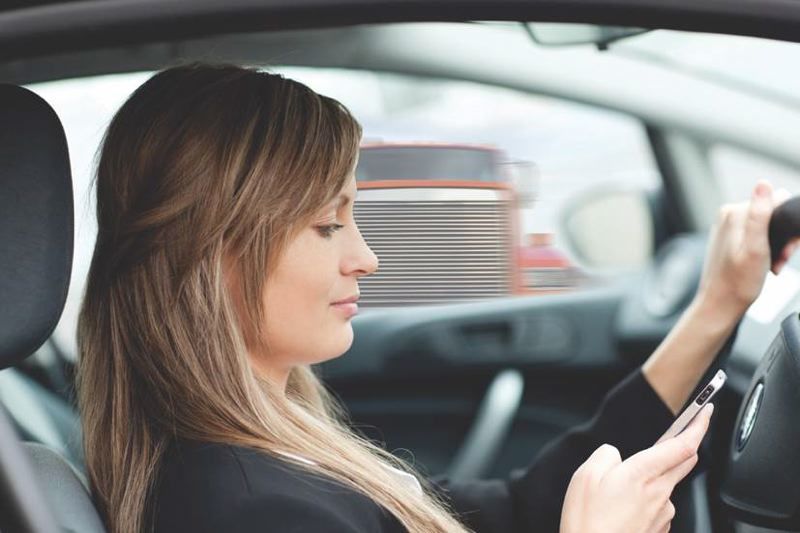What you can do under Oregon’s new distracted driving law
Published 8:00 am Wednesday, September 20, 2017

- OREGON DEPARTMENT OF TRANSPORTATION - A stock photo that was used by ODOT's Traffic Safety Division for a public education poster on texting and driving
SALEM — A new distracted driving law expands an existing ban on using cellphones while driving to all electronic mobile devices and stiffens fines and penalties, effective Oct. 1.
The law is aimed at improving safety conditions on Oregon roads. Drivers who talk on the phone are more than four times, and those who text are more than 23 times, more likely to have a crash, according to a report by the Oregon Department of Transportation’s Distracted Driving Task Force.
Violators face a fine of $130 to $1,000 for their first offense, $220 to $2,500 for their second offense, and a Class B misdemeanor conviction with a minimum fine of $2,000 and up to six months in jail for their third offense.
First-time offenders can avoid the fine by taking a distracted driving avoidance course, but the violation will remain on their record.
So, what can you still do with your mobile electronic devices while driving once the law takes effect?
When state lawmakers earlier this year changed the law, they came up with a limited list of exceptions to the ban. None of the exceptions apply to drivers younger than 18.
• Hands-free devices: Hands-free or built-in devices activated by voice command or activated while off the road are exempt from the ban.
Drivers also may talk on the phone while driving, if the phone is set to speaker mode and is not in their hand, said Lt. Timothy Tannenbaum of the Washington County Sheriff’s Office.
“You can have a conversation while it’s on your dashboard, or on the seat next to you, as long as you’re not having to type in numbers or manipulate the phone,” he said.
Traci Pearl, a manager with the Oregon Department of Transportation’s Safety Division, said a mounted phone is a safer alternative to looking down at the seat or console, but both ways are legal.
Single touch or swipe: Changes to the law allow drivers a single touch or swipe of a screen or button to activate or deactivate a device or function.
This is the exception that allows drivers to answer a phone call, or start a navigation map. It also is meant to allow Uber and Lyft drivers to respond to calls for service.
“If you can push one button to call the office, you are OK, but if you have to dial a phone number, that is not OK,” Pearl said.
• Parked: If one swipe was inadequate to find a desired destination, a driver could, under the law, pull over on the side of the road or in a parking space and legally use their electronic mobile device to, say, type in an address. But don’t try to do it at a stop sign or stop light. You could get a ticket.
• Emergencies: Drivers who are experiencing a medical emergency and have no passengers may use a mobile electronic device to summon help.
• Truck and bus drivers: The law makes exceptions to the regulations for truck and bus drivers, who cannot be cited provided they are abiding by federal rules for commercial driver’s licensees.
• Radio traffic: CB users, bus drivers, utility and truck drivers may use a two-way radio only for employment purposes.
• Emergency responders: Police, paramedics and firefighters, may use electronic mobile devices when responding to an emergency call.
• HAM radio operators: Old-school HAM radio operators could be a safety net for communication in the case of a natural disaster, such as an 8.0 earthquake, when other communication systems are down. That earned them an exception to the new restrictions.
The stricter law, born out of House Bill 2597, was a response to an incident in Washington County.
Oregon State Police arrested Beaverton resident Esmirna Rabanales-Ramos on drunken driving charges after a trooper reportedly saw the glow of a cellphone illuminate her as she drove.
In 2015, the Oregon Court of Appeals ruled the trooper had no probable cause to stop her, because using a cellphone wasn’t against the law, only using it to communicate.
House Bill 2597 “makes the law compliant with the intent,” Tannenbaum said. “The intent was to get phones out of people’s hands. It’s not hard to tell who is manipulating a phone. Surfing the Internet or checking Facebook while driving is just as dangerous as talking or texting.”
Geoff Pursinger of the Hillsboro Tribune contributed to this story.
Paris Achen
Portland Tribune Capital Bureau
503-385-4899
email: pachen@portlandtribune.com
Follow us on Twitter
Visit Us on Facebook





